Arrival at Khartoum airport. Included is a meet and greet at the airport with the guide and a transfer to your selected hotel. Dinner NOT included.



You will start your day with breakfast at the hotel, then late in the morning (11.30ish) you begin the journey northward through the Western Desert. You travel in a flat desert where the view can span 360° around before reaching WadiMuqaddam with its many acacia trees. You will stop at the “chai houses”, literally tea houses, simply a sort of very Spartan “motorway restaurants”, in the desert where local truck drivers usually stop for a quick meal and some rest. In the afternoon arrival you will arrive in Karima where you cancheck in at the charming Nubian Rest House just at the feet of Jebel Barkal.



The main landmark in the Nubian Desert; Jebel Barkal (“Jebel” means mountain in Arabic) can be seen from far away whilst still in the open desert. At the foot of this wonderful and isolated red sandstone mountain, considered holy since the ancient times, there is a big temple, dedicated to the Pharaohs of the New Reign and to their patron, Amon. Amon‘s ancient “Pure Mountain”, the Olympus of the Nubians, was the religious Nubian heart for more than 1000 years. Besides the ruins of the big temple there are still several sculptured granite rams that were supposed to border a long avenue that probably led to the pier on the Nile. In the mountain wall there is a big room decorated with bas-relief. The stunning Jebel Barkal archaeological sites are on the World Heritage list. After lunch you will move southwards to the village of El Kurru where there is one of the necropolises of the ancient capital, Napata. Here you can visit one tomb, which is excavated in the rock under pyramids – partially collapsed – and it is totally decorated with images of the Pharaoh, of the gods and multicolour hieroglyphic inscriptions. Not far from here there is an interesting site of petrified wood, an ancient forest with hundreds of huge trunks.A beautiful sunset at Jebel Barkal end a truly exceptional day.



After breakfast, you will visit the market in Karima, where you can have a real experience of the life of Sudanese people. Next it is time to board a small motorboat for a pleasant cruise along the Nile to enjoy the beautiful sand stretches and cultivated islands along the river. A little further northward there used to be the beautiful granite rocky formations of the 4th Cataract, which prevented the Nile from flowing slowly and formed many rapids that obstructed the navigation. In April 2008 the Dam of Merowee was completed and the flooding of the artificial lake started. You will have a lovely picnic in the area. After lunch, you visit the archaeological site of Nuri where you can see many pyramids among which is the one of the great Taharqa. A short walk and then return to the Nubian Rest House for dinner and overnight stay.
Today it is a long day on the road but full of interesting encounters and visits. Early in the morning you visit the animal market of Tengasi and then follow the Nile until you reach the archaeological site of Old Dongola. Here there are the remains of a Christian Coptic temple with marble columns as well as several suggestive ruins of churches situated on the banks of the Nile. This area is the central part of the Nubian region. Here the population lives in small villages amongst yellow sand dunes and palm trees. They speak a different language from the Arabs and also the Islamic religion is not as “strict” as in other regions. The women don’t cover their faces and readily speak to foreigners. Some houses in the Nubian Villages are painted with flower patterns, but most of them are completely white. You can eat your picnic (with provided food) in one Nubian house, but the tea and coffee will be prepared by the Nubian family. In the evening return to the Nubian Rest House in Karima. Dinner and overnight stay.
After breakfast you cross the bridge over the Nile to enter the Bayuda Desert, an area bounded by the loop formed by the Nile between the 4th and the 6th Cataract and characterised by sharp black basalt mountains, most of them volcanic and typically cone-shaped. It is very likely that you will meet isolated groups of Bisharin nomads, who live in familiar groups in small huts made of intertwined branches close to the rare water wells, with their caravans and herds of camels and donkeys. You will then cross the Nile again with the ponton, a local ferry boat. These ferries are a hive of colourful activities. You will find yourself sharing space with people, donkeys, camels and goats.......then all of a sudden you can glance at more than 40 pyramids, located on top of a hill, some of them perfectly preserved, which belong to the Royal Necropolis of Meroe. Arrival at the Meroe Camp is accompanied by a beautiful view of the pyramids. Accommodation in comfortable and fully furnished tents, dinner and overnight stay.


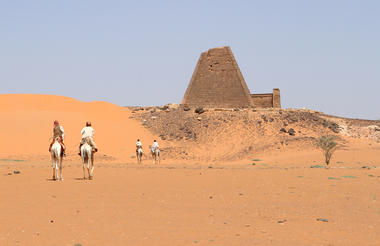
The morning is dedicated to the visit of the pyramids. The Royal Necropolis of Meroe is located at about 3 km from the Nile on some hills covered by yellow sand dunes. Several pyramids stand out with their sharp shapes against the clear sky. Each one has its own funerary chapel with the walls fully decorated with bas-reliefs that show the King’s life and offers to the gods. In the afternoon you move along the Nile to visit the ruins of the Royal city. The excavations confirm that the town of Meroe used to cover a large area and the Royal city was located in a central position, surrounded by suburbs and a boundary wall. Most of the area where the city is located, formed by many small hills covered by red clay fragments, has still to be excavated by the archaeologists. Dinner and overnight stay at the permanent Meroe Camp.
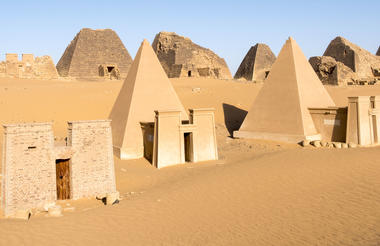
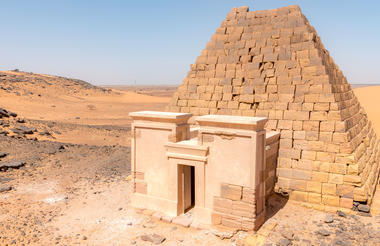
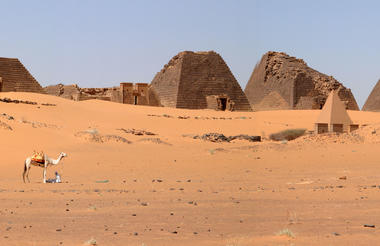
Breakfast is at camp and then after about a one hour drive you leave the asphalt road and drive for about 30 km on a desert track among many camel thorn acacia trees to visit the two archaeological sites. The site of Naga it is one of the two centres that developed during the Meroitic period. In Naga, in a typical Saharan environment with rocks and sand, you find a temple dedicated to Apedemak (1st century A.D.): a wonderful building with bas-relief decorations depicting the god with a lion’s head, the Pharaoh, noblemen and several ritual images. A few metres away there is a small and odd construction with arches and columns, named “kiosk“, in which you can notice Egyptian, Roman and Greek styles. Not far away you reach another temple dedicated to Amon with many statues of rams and beautiful gates decorated with bas-reliefs. Then it is on to Mussawarat, not far away from Naga. This settlement is located in a beautiful valley crowned by hills. Its main characteristic, the “Great Enclosure” is made by many constructions and boundary walls which surround a temple built in the 1st century A.D. The large number of elephants represented on these walls makes you think that this animal used to have an important role in this area. Beyond the big wadi there is another temple – restored by a German archaeological mission – dedicated to the god Apedemak. Picnic in the area and then return to the main road. You get into a desert area covered with huge round granite boulders; these are the last offshoots of the rocky formations of the 6th Cataract. You continue your trip until Omdurman where at sunset time you may get to attend the involving Dervish ceremony (only on Fridays). Arrival at the hotel. Check in and overnight stay.



Breakfast is at the hotel followed by a Khartoum city tour. You first visit the Archaeological Museum that, besides many beautiful objects, contains two beautiful temples rescued by UNESCO and moved from the Lake Nasser area, when it was flooded by the water. You then cross the confluence between the Blue and the White Nile near the Presidential Palace where in 1885 General Gordonwas beheaded by the Mahdi’s troops and reach Omdurman, the old capital of Sudan. Here you see the Mahdi’s Tombfrom outside and visit the interesting Khalifa’s House which holds a small museum about the Mahdyia. Lunch included in a local restaurant on the Nile. Then visit the colourful souk of Omdurman. At sunset time you move to Khartoum North to attend the traditional Nuba Wrestling (only on Fridays, Sat and Wed). Return to the hotel, Dinner NOT included.
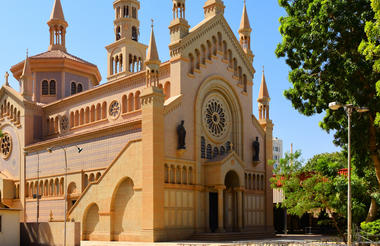
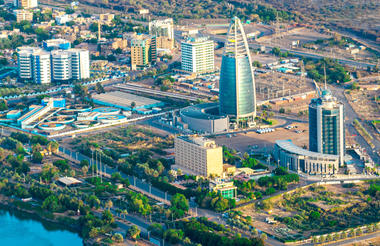
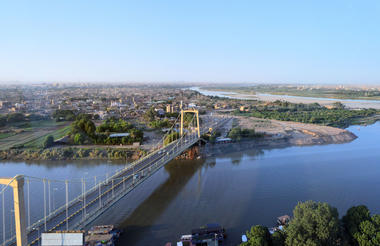
You will be picked up at an agreed time and transferred to the hotel for your onward flight or flight home. It is compulsory to your visa that your are escorted to the airport by the arranged transfer.






